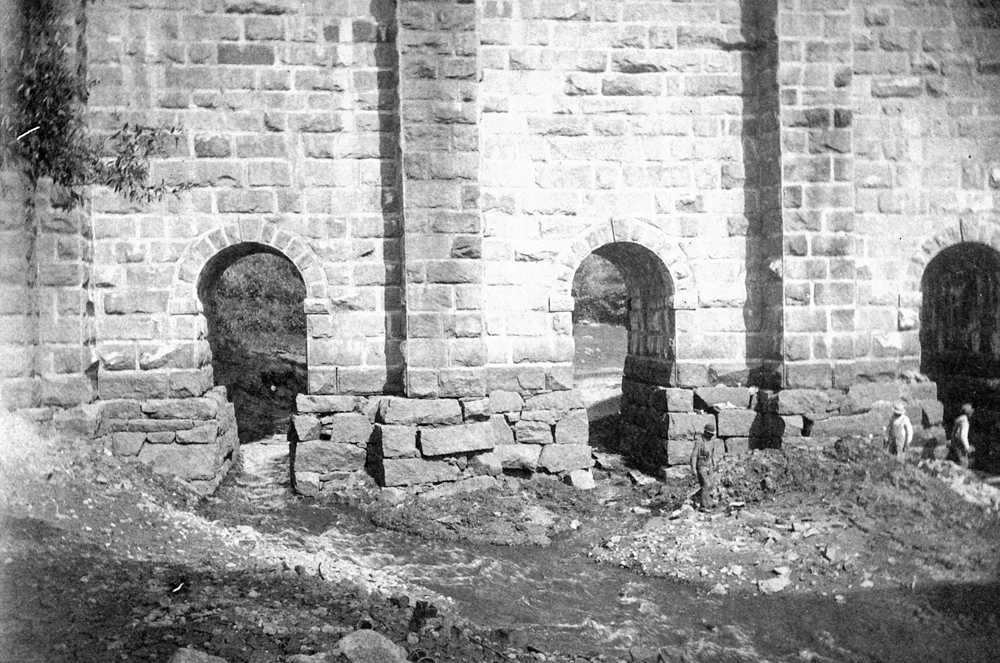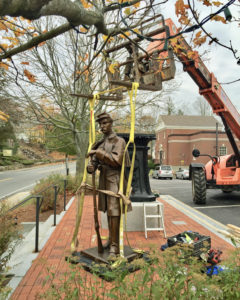True Tales: Taking Stock of Preservation
By George T. Comeau
Workers repairing the foundation of the Canton Viaduct in 1897 (Courtesy of the Canton Historical Society)
A few weeks ago I was invited to the Canton Senior Center to speak with the Canton Women’s Club. The invitation came at the behest of a dear friend over a year ago. As has always been my practice, I had been thinking about the subject matter for several months. My mind ran through so many wonderful stories that have been written here in this column.
I have always viewed this space in the Canton Citizen as both a gift to me and to posterity. As someone who researches local history, the value of old columns and stories is never lost on my bi-monthly efforts. In fact, the noted Canton historian Daniel Huntoon wrote most of the early town history for a newspaper column and that material became known in book form as Huntoon’s History of the Town of Canton. That seminal book was published in 1893 and still today is the go-to resource that helps answer so many questions about our past.
At this point, you are reading column number 189. This year in November will mark the ninth year of these stories, and my wife implores me to end this run on the 10th year. We shall see. Myself and a co-author are planning a book that could be released in early 2020, so there are more things to write. There is an embarrassment of riches in our local history, with so many stories still untold. And as I prepared to speak with the women’s group, I also decided to take the pulse of historic preservation in Canton. After all, and when all is said and done, my hope is that I will be seen as a preservationist. Working, and sometimes fighting for our place, our stories and our heritage.
Preservation in Canton is actually an old story. It was Huntoon who implored people to save the scraps of paper on which our earliest history is written. Three large tomes were carefully put together. The earliest records from the mid 17th century all the way through the late 18th century were preserved. And today these books are the subject of an upcoming Community Preservation Act (CPA) project to make sure they are digitized and last for several hundred more years. So, the credit for early preservation must go to Huntoon.
Another major preservation effort came in 1897, when the Canton Viaduct was thought to be in precarious structural shape. As a result of concerns from engineers, the water that flowed under the bridge was diverted, and laborers rebuilt the foundation of the bridge where it had eroded. There are superb photographs of the work, and of course the bridge still stands today. Yet in 1906 there was another call for demolition of the structure, which meant it would be replaced with a “modern” steel structure. By 1909, a stone in deck arch 10E dropped out of place and the arch was badly cracked; stonemasons began repairing it on Sunday, December 19. An article titled “More Trouble with the Viaduct at Canton Junction” in the December 24 edition of the Canton Journal describes this as the second arch to have given way within a month. Once again, the future of the Viaduct was unclear. Wilbert H. Jerauld, the railroad foreman had noticed the failures of the stonework, and something had to be done. Through 1910 and 1912, each of the arches was reinforced and the topic of condemning the Viaduct was never brought up again. Jerauld was killed on the structure in 1914 within 100 yards of his home just opposite the bridge.
The bridge is a National Historic Site and is emblazoned on our town’s police patches, various letterhead, and is a symbol for Canton. It is a fantastic story of preservation and has stood the test of time since it was built in 1834. And yet sometimes we have lost precious items here in town, only for them to appear elsewhere. The Fenno House is a great example. The house was built in 1724, although some sources believe it may date to 1704. In 1934, the house was owned by the Saltsonstall family and they offered the relic to the Canton Historical Society. A debate ensued at the time, and the society felt that it had a larger obligation to take care of its own building and was not in a position to save the venerable old Fenno. In 1949, the house was given as a gift to Old Sturbridge Village and remains the oldest house in their collection.
Likewise, the Vose-Maudsley Tavern was lost to Canton in 1990. The historic tavern was built between 1725 and 1737. An architectural expert wrote his report at the time of the loss that the building consisted of “twelve rooms resting on a stone foundation … a floor plan that is quite rare in its containment of four fireplaces around the chimney with cupboards above (likely an indication of tavern usage) … it is a handsome finely crafted frame of mid-eighteenth century in its own right … the triumph of the early interior is its extent of paneled and sheathed detail…” The report concluded that there was a “wealth of untouched interior of 18th century trim and rare four-fireplace floor plan.” The analysis revealed a hidden room in this “rare, unique and high quality” building. By October, the building was taken apart piece by piece and today is a 4,500-square-foot home valued at close to $2 million on nearly four acres of land in Lincoln, Massachusetts. Saved — just not here.
Over the past 10 years, we as a community may have come full circle. We have a handful of National Historic Sites, an inventory of nearly 800 historic homes and public buildings as well as archeological assets, ancient burial grounds, and other structures in the state inventory of historic places. We have a demolition delay bylaw that helps take stock of buildings we are about to lose. And we have the Community Preservation Act.
The CPA has enabled us to spend more than $1 million on a variety of preservation projects. And that money doesn’t even include the purchase of the land at the Paul Revere Heritage Site coming in at $1.8 million. Preservation projects through the CPA have saved one of the nation’s oldest and most important quilts, the Civil War statue at Memorial Hall, literally hundreds of gravestones in our public cemeteries, the firefighter’s bell in Ponkapoag, the doors at the Canton Public Library, and the steeple at First Parish in which rings the Revere Bell. Most near and dear to this writer is the preservation of the nearly 300-year-old Tilden House. Every day, the Tilden reveals past stories in vivid details against the backdrop of preservation. A single photo of the work at Tilden has garnered more than 500 “likes” on Instagram as our preservation story works its way around the world.
The work of preservation has only just begun. Future projects are exciting and include destination stops in our town that tell our story in ways yet unrealized. Exhibit space at the Revere Heritage Site will begin to tell the tale. Interpretive signage will lead visitors through our heritage, and one key to all of this is the support of the citizens of Canton who are coming to value the culture and past while embracing a future for historic Canton. Now, onto story No. 190.
Short URL: https://www.thecantoncitizen.com/?p=53551











